Dutch Navy WW1
 The Netherlands at sea in the Great War
The Netherlands at sea in the Great War
Creation in 1488
The Koninklijke Marine was first formed as a semi-independent local Habsburg fleet in 1488, but was really formalized and independent at the end of the Eighty Years’ War (1568–1648), from the House of Habsburg. She reached a peak during the Dutch Republic era (1581–1795), having at some point the world’s largest navy, which was pitted against England, France, and Spain’s own mighty fleets. During this golden age of great galleons and Indiamans, the Dutch Republic naval forces were spread among five separate admiralties (three in Holland, one in Friesland and Zeeland) operating local fleets, up to command organization, and revenues. The famous VOC (Dutch East India Company or Vereenigde Oostindische Compagnie) chartered in 1602 had its own fleets, armies, organization and command plus an international network of naval bases and colonies. This was the first modern global company, a state withing the state. The VOC was eventually closed when Napoleon’s armies conquered the Netherlands, after 200 years. This makes this navy almost the oldest in Europe.

Old Glories and remembrance: Willem Van de Velde victory over the British at Scheveningen on August, 10, 1657, part of the First Anglo-Dutch War.
The XIXth Century was bleaker for the Dutch as a declined, which started from after 1713 and cluminated in the 1780. At this point, the Dutch Marine was no longer a match for the French and British navy, despite an ambitious revival in 1780, the fourth Anglo-Dutch War (1780-1784) was a catastrophe, the Dutch allowing free passage throughout the East Indies whole until 1789 what remained of the home squadrons were sent to the Dutch East India Company. Reforms with the academy and command structure occurred with the Batavian Revolution (1795) and a central organisation was funded in The Hague.
The fall of the Empire
However warships stayed in dry-docks, a few conveying William V to Great Britain and the others sailing to East Asia. In 1796 a squadron surrendered at Saldanha Bay (1796) while the lost Battle of Camperdown in 1797 followed by the surrender of the fleet near the Vlieter in 1799 erased what was left of the Batavian navy, now part of Imperial France. After regaining independence in December 1813, the Dutch navy was revived. But later in the 19th century, it suffered from a constant shortage of manpower. In addition, bankruptcy of the East India Company, against the bulk of the home fleet shifted to East Asia in 1850, with the “Government Navy”.
The XIXth Century
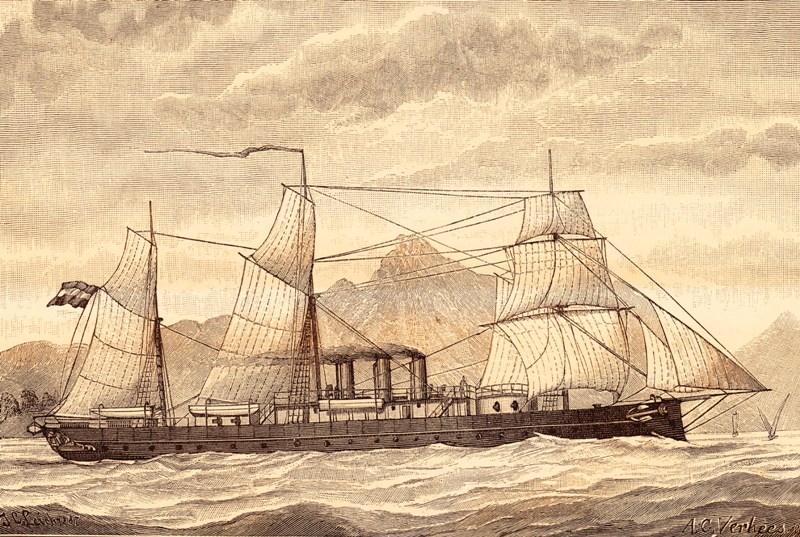
Koning der Nederlanden 1874
The navy began to modernize the fleet, introducing a series of monitors, two large turret ram ship (then ordered abroad). From 1867 however, the Rijkswerf in Amsterdam was the first shipyard modernized and capable of delivering major, modern all-steel warships. In the 1890s series of protected cruisers and coastal defense ships was introduced, with what became the Royal Netherlands Navy in 1905. The first submarines were introduced in 1910, and there were plans to order several dreadnought battleships in 1912.
List of articles
- Reinier Claeszen (1891)
- Eversten class (1894)
- Konigin Regentes class (1900)
- De Zeven Provincien (1909)
- 1912 Dutch dreadnought (project)
- Holland class cruisers (1896)
- Fret class destroyers
- Dutch Torpedo boats
- Dutch gunboats
- Dutch submarines
- Dutch minelayers
1914-18 Operations
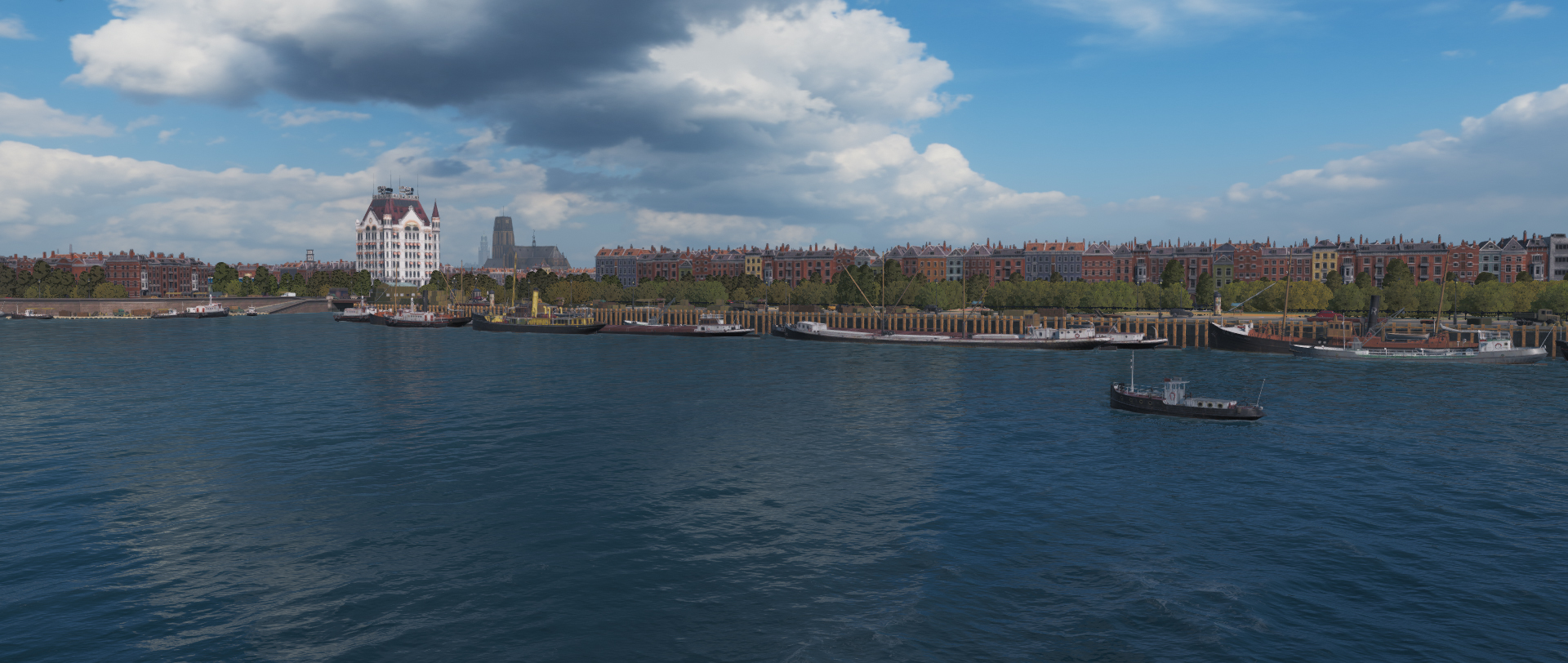
Amsterdam at the start of the century (wow screen)
In 1914, the Dutch fleet was in the same position as other Scandinavian fleets, having only one coast defense squadron to defend its shores and several obsolescent cruisers and torpedo boats. She was totally outclassed by the Hochseeflotte at home, while the bulk of her naval forces resided in the “pearl of the empire”, future Indonesia, facing since 1905 the rise of Japan’s empire, overconfident after Tsushima. Achin’s war had, by its duration (1873-1904), considerably drained treasure, and naval budgets could only be modest. The metropolitan fleet could only waged a delaying action against the German navy, since the real perile came obviously from land. On the Dutch East Indian Squadron, based at Java, the fleet could at least resist better to the Japanese until the help of one of its potential allies, like nearby Great Britain. That was all theoretical as the Netherlands remained neutral. In addition, by 1914 the British own Indian fleet had been withdrawn for the benefit of home waters; no longer there as a wild card. The French navy of Indochina could only deploy minor units, while the Chinese fleet was inoperative, divided between local warlords, of dubious allegiance and value.
Therefore in 1908 at last, a vast rearmament plan was decided: Four coastal battleships of 7,000 tons were ordered as well as submersibles and destroyers. The main focus was however on mine-laying capabilities in order to immobilize the adversary or channel it towards coastal artillery or strong torpedo forces.
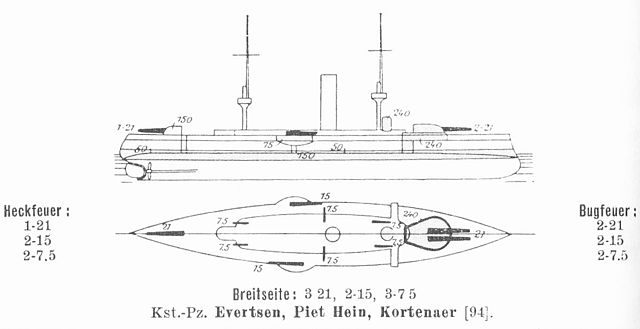
A royal commission was appointed to study the question of defense of the East Indies, and recommended in 1913 the starting of 5 dreadnought battleships in the 20,000 tons range, as well as four for home waters as well as fifty destroyers, dozens of torpedo boats and large submersibles, as well as new minelayers. It was also planned to reinforce Batavia, transform it into a fully fledged fortified naval base with coal reserves and three forts own heavy artillery. With political opposition to this proposal, a crisis broke, and the plan was not voted on until August 1914. The outbreak of the war made it obsolete.
So here is the fleet strength on this date:
7 Coastal Battleships: De Zeven Provincien (1909), Kortenaer (1894-Evertsen class survivor), and five smaller Konigin Regentes (1900-06).
4 Cruisers: Classe Holland (1896-98).
8 Destroyers: Classe Fret (1910-13).
35 Topedo boats: 16 classe G (1904-14), 3 classe Draak (1906), 2 classe Ophir (1901), 5 classe Hydra (1900), Makjan, 4 classe Ardjoeno (1888). Seconde class XXI (1890) and 3 classe K (1905). 8 more in construction.
6 Submersibles: O1 (1905), 4 class O2, and K1 (1913). Two more on order.
35 Misc.: 3 armoured gunboats Brinio class (1912), 2 minelayers Hydra class (1911), gunboat Borneo (1892), 2 Nias (1897), 3 Koetei (1898), 8 Hydra (1873-76), 16 Wodan (1877-79).
Tonnage 1914:
7 Coastal defence ships
4 Cruisers
8 Destroyers
6 Submersibles
35 TBs
35 Misc.
The Dutch Navy that never was: 1912 and 1924 plans
1912 Dutch Dreadnought
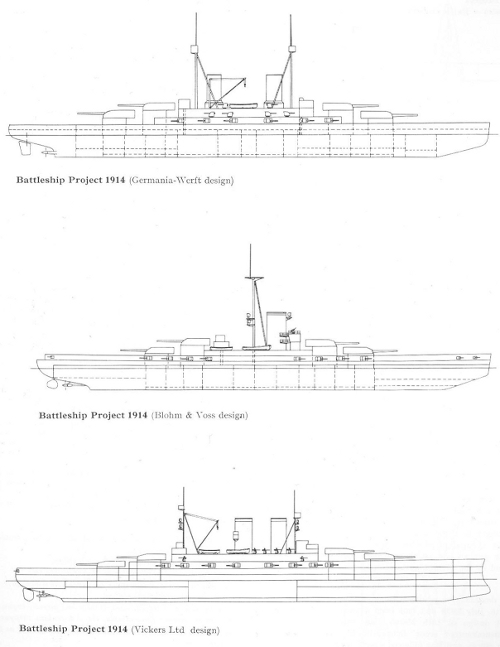
Germaniawerft design (top) and the two others.
This topic is a bit of sea serpent, with lots of literrature and some fantastic designs. Theses projected battleships were basically the results of the Royal Commission on the defence of the East Indies. Like as it was disconnected from the Dutch economy and worked in a vacuum, this commission proposed the construction of no less that nine dreadnoughts. For the Netherlands, which never went further than a large coastal battleship, this was nothing short of revolutionary. Discussions went on until consensus appeared on a single design: 24,665 tonnes, 21 knots, eight 13.5 inches (356 mm), sixteen casemated 5.9 inches, and twelve 75 mm guns. The Dutch givernment itself proposed to even enlarge the elected proposal.
Soon, tenders were offered to major shipyards of the time, Germaniawerft, Blowhm und Voss in Germany and Vickers in UK. Requirements notably were really specific in decreasing slightly the armour thickness in favor of a better speed, tailored for duels in the Java sea. Better than average hull protection also, against mines and torpedoes. In the end the Germania design was chosen (see tables below) as the closest to Dutch requirements. However the program was eventually not approved, no order was passed, and if it had, the proposed date for it of December 1914 would have been doomed by the war. Ships built in Germany would have been almost immediately scrapped, or completed for Germany. If built (with no war) completion dates would have been around 1918.
Eight battleships would have probably changed a bit Japanese plans in WW2 for the Dutch East Indies, but not much. Another pearl-harbor style attack was indeed possible at Sorebaya and Java in early 1942. In the end, the cost of such endeavour was simply too much for the Netherlands. Apart the Java class, the only interwar major naval program was the sold light cruiser De Ruyter, a far cry from an eight battleships fleet.
Specifications (Germania design 1914)
Displacement: 24,600 tons standard, 26,835 tons FL
Dimensions: 184 x 28 x 9 m (603 x 91 x 30 ft)
Propulsion: 3 shafts turbines, 6 Double boilers, 38,000 shp, 22 kts, 2040 tons oil
Armament: 8x 356mm (14 in), 16x 150mm (5.9 in), 12x 75mm, 5 TT sub.
Armour: Belt 150-250, Bkhds 200, TBkhds 40, Bbets 300, Dck 50, CT 300mm.
Crew: 900+ est.
- Vickers 558 – Length: 152,4m. Displacement: 18600 ?. Speed: 21 kts. Armament: 8x 343mm, 2×1 533mm TT. Belt: 230, Citadel: 100-150, Turrets: 76, Barbettes: 250, CT: 250
- Vickers 592 – Length: 137,2m. Displacement: 14000 ?. Speed: 21 kts. Armament: 6x 356mm, 2×1 533mm TT. Belt: 230, Citadel: 150, Turrets: 150, Barbettes: 230, CT: 230: Denied due to being too expensive according to The British Battleship 1906-1946 by N. Friedman.
- Panterschip 1913 – Displacement: 17000 std. Speed: 20+ kts. Armament: 8x 305mm L50 4x or 6x submerged TT. Belt: 300, Deck: 25 or 75, Turrets: 300, Barbettes: 300, CT: 350, Bulkheads: 300 (source: Marineblad jrg 27 1912/1913 volgno 4.)
- Germaniawerft 743 – Length: 174m. Displacement: 21300 std. Speed: 22 kts. Armament: 8x 343mm 4x submerged TT 533mm. Belt: 250, Deck: 25+25, Turrets: 300, Barbettes: 300, CT: 300, Bulkheads: 37
- Germaniawerft 753 – Length: 174m. Displacement: 22000 std. Speed: 22,5 – 23 kts. Armament: 8x 343mm, 3x submerged TT 533mm. Belt: 250, Deck: 25+25, Turrets: 300, Barbettes: 250, CT: 250, Bulkheads: 40
- Armstrong 793 – Design 793 26 May 1914: 25,600 tons (560ft/597ft oa x 89ft x 28ft, forecastle depth 43ft amidships/50ft to forecastle), armed with eight 14in, sixteen 6in, eight 3in (anti-torpedo guns), four 3in AA, seven 21in TTs
- Vickers Design 793A, same displacement, longer (580ft/617ft x 89ft x 28ft)
Lichtendahl’s Superdreadnoughts and 1923 naval plan
In 1919 the “Lichtendahl” Superdreadnoughts and a Battlecruiser were envisioned in the essay of that year called “De economische, politieke en strategische ligging van Indisch-Nederland”, by lieutenant 1st class N.F. Lichtendahl. Recommendations for a 30 000 ton Super-Dreadnought & cruiser fleet led by a 27,000 tonnes battlecruiser capable of 26kts. He predicted that East Asia was was going into an era of economical and military decline, and was going to be hihmy vulnerable to foreign expansionism. The Dutch cabinet, in concertation with and Dutch East Indies government decided to plan a good defence aimed mostly at Japan, upon Lichtendahl’s recommendation. He foresaw that without good preparations, the colony would fall within 2 months to the Japanese.
It was believed a fleet in being needed to be mustered by 1922-1924, consisting of a single division of battleships of four 30.000 ton super dreadnoughts and a flotilla of eight destroyers, on division of cruisers led by a single 28.000 ton battle cruiser and three 7.000 ton protected cruisers plus three 1.500 ton scout cruisers, three 3 flotillas of submarines and a torpedo cruiser, three torpedo boats and ten submarines for coastal defence. He planned this in order to repel a force expected to comprise 8 super dreadnoughts supported by cruisers, in the Java Sea. Then, the plan once approved, cost issues were studied:
Four super dreadnoughts at 160 million, one battle cruiser at 40 million, three protected cruisers at 30 million total, 3 scout cruisers at 12 million total, three torpedo cruisers at 9 million, 8 destroyers at 12 million and 9 torpedo boats for 9 million plus 30 submarines for 45 million which made a grand total of 317 million Dutch guilders, added to that 35 million for new naval base and renovating the old ones, and built a coastal naval air force, which represented 352 million (less available bases and material) but 8 million for unsuspected costs, for a grand total of 280 million Dutch guilders, and 20,87 million Dutch guilders for maintenance and training, 4 million for the management of the arsenal, the support department and administration, for an added 24,87 million Dutch guilders.
Needless to say, such sums were painful to hear in a time of resolutely pacifist opinion, but in 1923 the Dutch cabinet was pressed to modernize the navy seriously. However, the Vlootwet 1924 of naval bill FY1924 did not passed the vote at Dutch Parliament on 26 October 1923… with the difference of just one vote. Budget was curtailed to cosmetic additions, until WW2 was at the gate, and a new ambitious plan was launched, of course too late. As predicted in early 1942, the Dutch colony fell in less than two months, hopeless with its limited fleet, and even with allied reinforcements (ABDA) to face the IJN juggernaut. Src
Situation at home
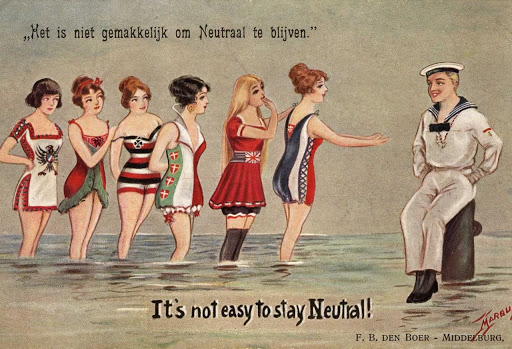
“It’s not easy to stay neutral”, Dutch humoristic postcard of WWI.
In 1914, the Dutch fleet was in the same position as Scandinavian countries, having only one coast defense squadron to defend its shores, totally outclassed by the Hochseeflotte, the expansionist Reich being the most feared at the time. west, while the bulk of his naval forces resided in the “pearl of the empire”, Indonesia, and had to face the rise of Japan’s empire, considerably strengthened since 1905 in morale, confidence and capabilities. The Achin war had, by its duration (1873-1904), singularly impoverished the treasury, and naval budgets were curtailed.
The metropolitan navy could not do much against the German navy, but the real military peril came in the occurrence of the land. On the Dutch Eastside, the Japanese fleet outclassed the squadron of Java, but at least it had to resist until the concurrence of one or all the allies.
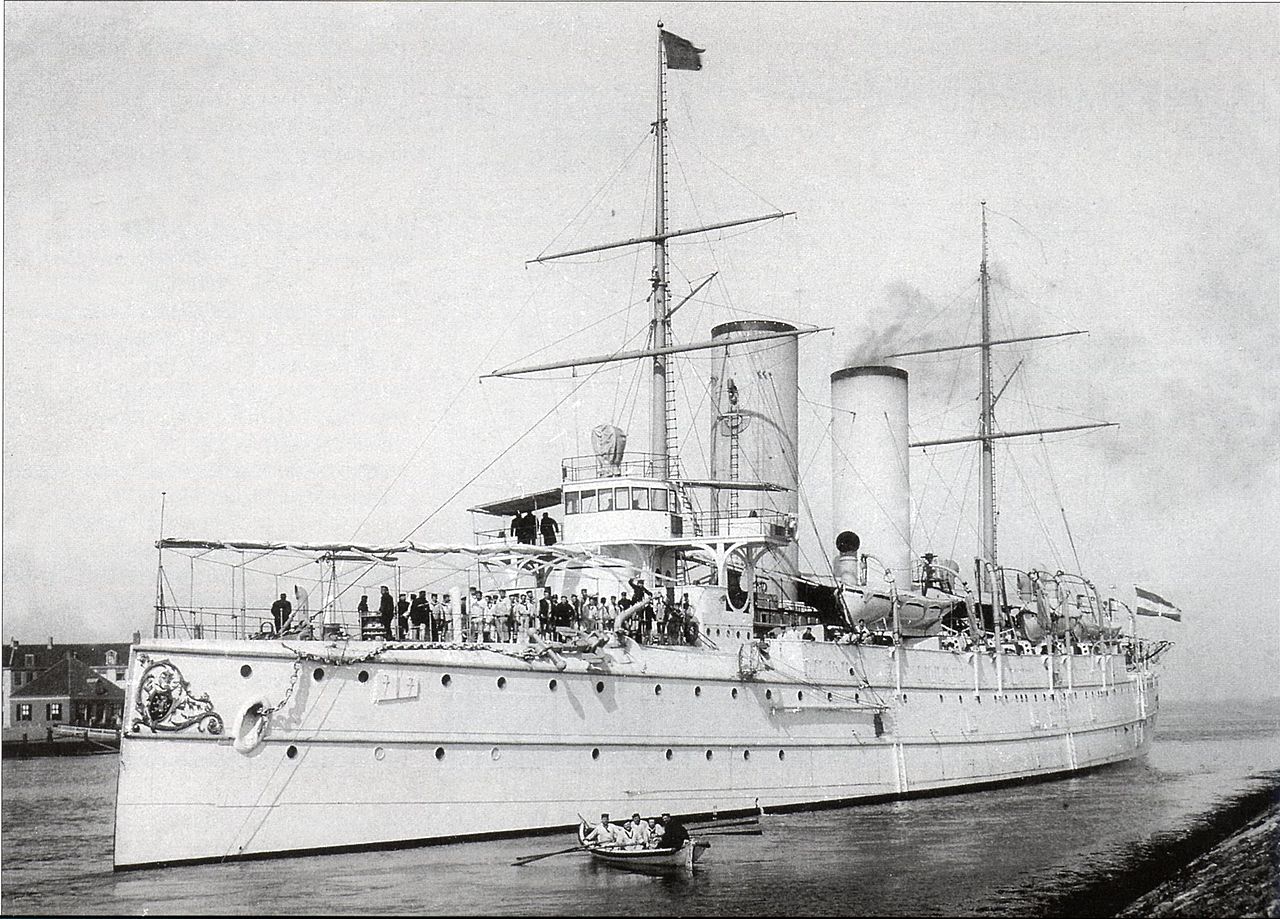
HNLMS Noord-Brabant
The Dutch Empire’s last colonies
However, the prevalent budgetary constraints policy had its limits. Against Japanese appetites, the Russian Pacific Fleet no longer resisted after 1905, while the British Indian Fleet had been withdrawn for the benefit of the Metropolis. The French navy of Indochina could only deploy minor units, while the Chinese fleet was inoperative, crippled after 1894, and stranded because of its division between local warlord and the regime’s corruption, rarely able to fight. In 1908, a vast rearmament plan was decided: Four coastal 7000 tons battleships and are submersible plus destroyers. The main focus was on minefields, to immobilize the adversary or force an enemy to pass through areas beaten by coastal artillery, mined and easily defended by few ships. The classic “Salamine trap”.
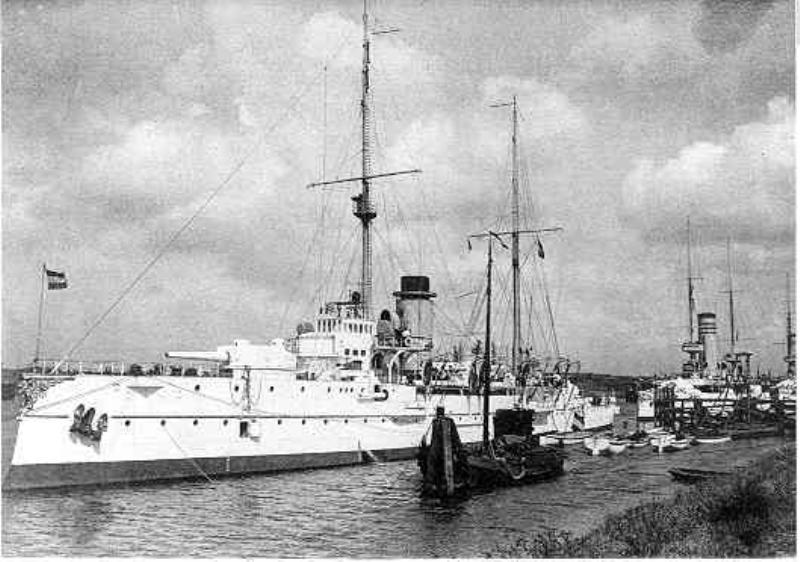
HNLMS Jacob van Heemskerck (1906)
A royal commission was appointed to study the question of defense of the East Indies, and it recommended in 1913 the start of construction of five 20,000 tons dreadnoughts for this sector, but also four for the metropolis, assisted by about fifty destroyers. There were also dozens of torpedo boats and large submersibles, as well as new minelayers. It was also planned to reinforce Batavia, transformed into a naval base with the addition of coal reserves and defended by three forts. Despite the political opposition that provoked a crisis, the plan was not voted on until August 1914. The outbreak of the war made it obsolete.
Here are Dutch naval force at the eve of WWI:
7 Coastal Battleships: The De Zeven Provincien (1909), the Kortenaer (1894), a survivor of the Evertsen class, and the 5 class Konigin Regentes (1900-06).
4 Cruisers: 4 Holland class (1896-98).
8 Destroyers: Freja Class (1910-13).
35 Raiders: 16 Class G (1904-14), 3 Class Draak (1906), 2 Class Ophir (1901), 5 Class Hydra (1900), the Makjan, and 4 Class Ardjoeno (1888). Second class: The XXI (1890) and 3 class K (1905). 8 others planned under construction.
Submersibles: O1 (1905), O2 class, and K1 (1913). Two others planned.
35 Miscellaneous: 3 armored gunboats class Brinio (1912), 2 Hydra class minesweepers (1911), the Borneo gunboat (1892), 2 class Nias (1897), 3 class Koetei (1898), 8 multipurpose ships class Hydra (1873 -76), and 16 class Wodan (1877-79).
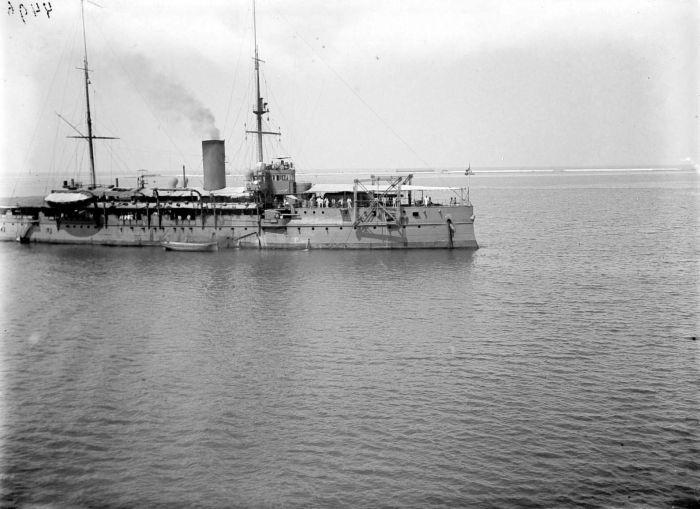
HNLMS Hertog at Hendrik at Makassar strait (1906)
The Batavian Navy during the First World War:
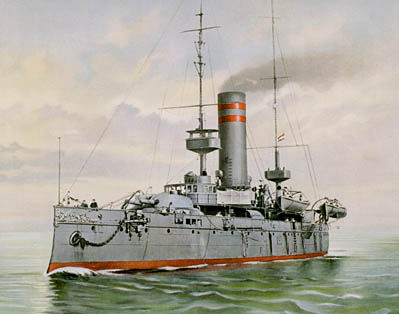
The neutrality shown by Holland in 1914 was one of the most difficult to hold: Neighbor of the Second Reich, whose armies would have made a mouthful of her, granting herself valuable opportunities on the North Sea, it should also spare the Japanese, neutral too, but who could then very well switch to the camp of the triple alliance. Its imposing maritime trade, with Germany as well as with Great Britain, was also a powerful obstacle to any engagement.
With the blockade imposed by the English and the severe control of the merchant traffic, economic activity was significantly weakened. In practice, the reception of German cargo ships was almost impossible, a consortium of Batavian merchants committing themselves to it and Great Britain keeping the right to “blacklist” the offending importers, particularly by weighing on coal imports allocated to companies.
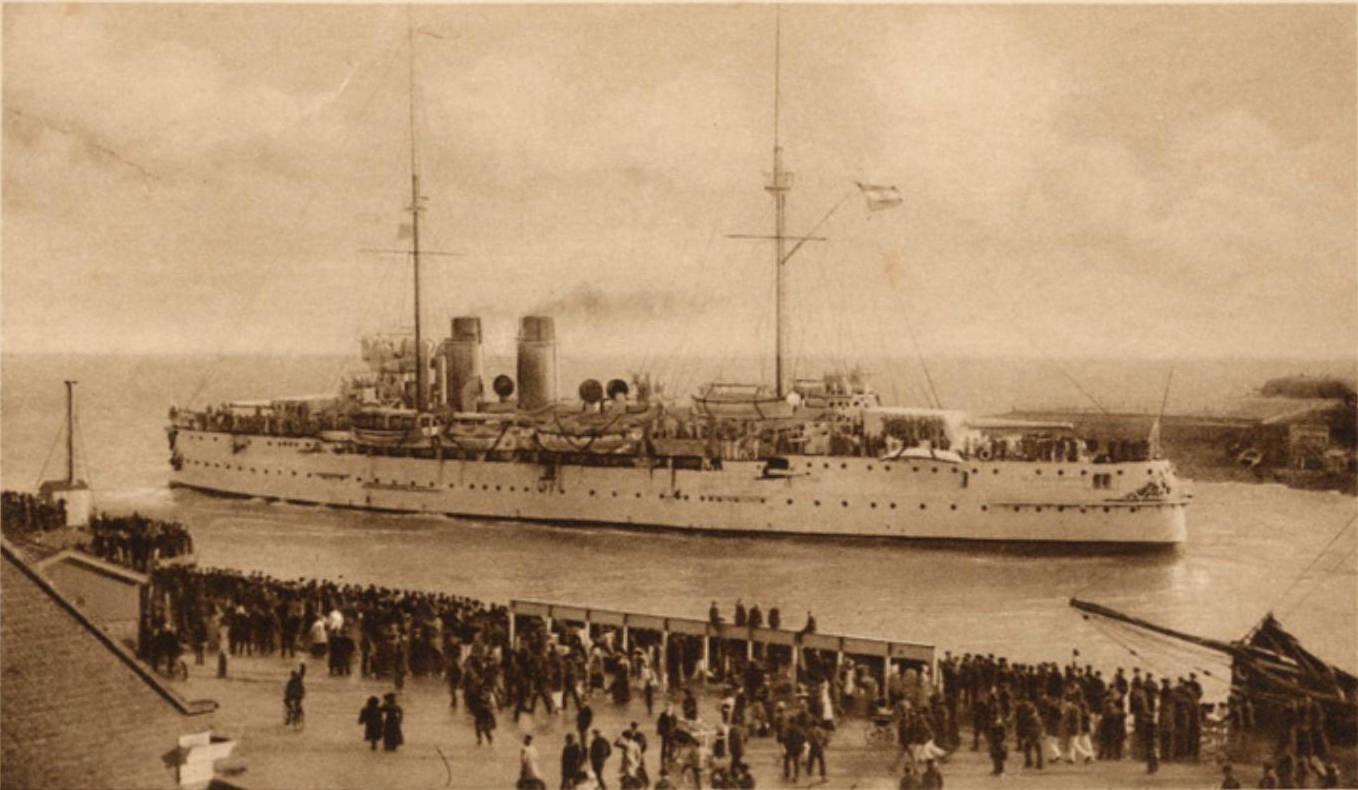
HNLMS De Zeven Provincien departing for the East Indies (1910)
However, blockades were always possible, thanks in particular to the intermediaries represented by the Scandinavian countries. Thus Germany received millions of tons of Norwegian iron passing through Rotterdam. A large illegal food trade also developed illegally, with the black market inflating prices and freeing appetites from many adventurers… The Royal Navy also did not hesitate to pursue German blockade enforcers in Dutch waters; Those who passed through the Batavian ports were not in principle worried.

Plans HNLMS Koningin Regentes
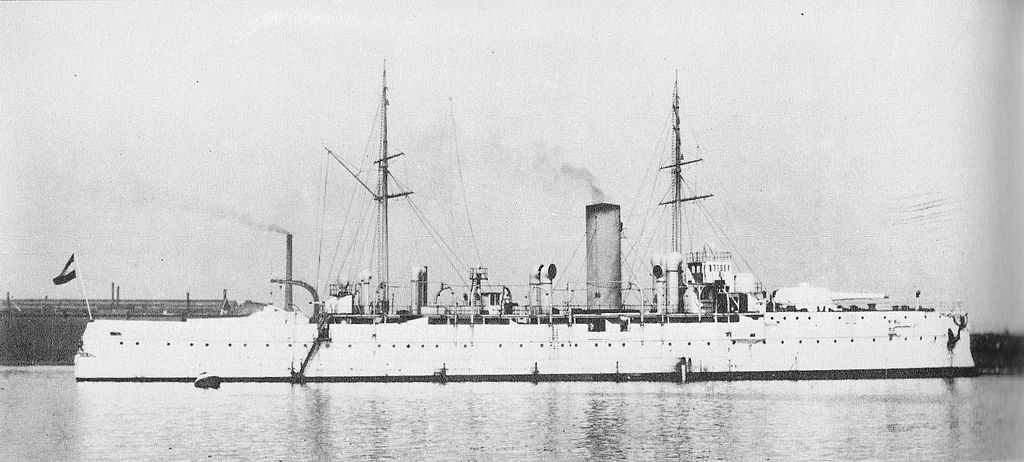
HNLMS Koningin Regentes (1898)
In 1917, with the development of submarine warfare, the Dutch were not spared and lost, despite their safe conduct, 230,000 tons of commercial ships, worth 147 million pounds sterling. New ships constructions were launched: In 1916, two cruisers of the Java class, completed in 1925-26, 6 torpedo boats class Z, 2 submersibles class O6, the KII, 2 class KIII, 3 class KV, 3 class KVIII (these last completed after the war, in 1919-23), 2 trawlers and 5 tugs converted as minelayers, 2 Van Meerlant class minelayers. In addition, two submersibles, a German type UC and an English type H were recovered after sinking in home waters and were reused by the Navy, under the names of M1 and O8.
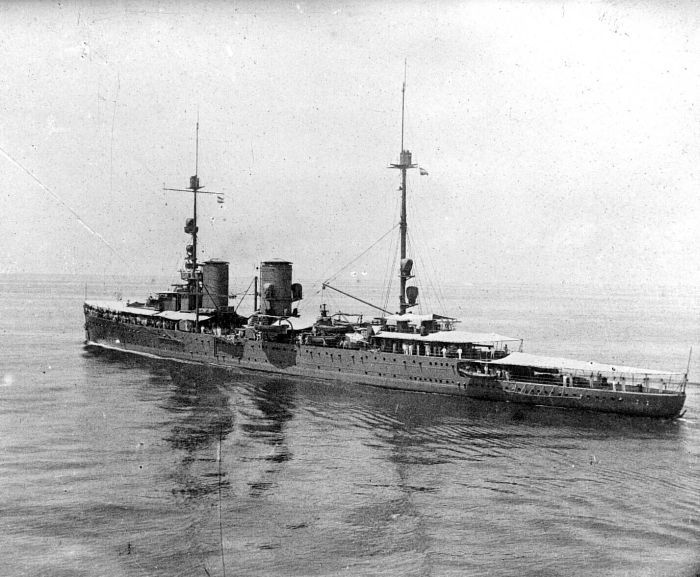
HNLMS Cruiser Java, launched 1920.
The Dutch Navy in detail
Coastal Battleships
Reinier Claeszen (1891)

Certainly the oldest of the lot, named after Vice Admiral Reinier Claeszen, this 2,440 tonnes vessel was no longer operational when WWI broke out, but since only four months. Hr.Ms. Reinier Claeszen was built as a ram armoured ship, at the Rijkswerf in Amsterdam. She launched on 21 November 1891 and commissioned on 1st March 1894 in Hellevoetsluis, her construction costs was 1,960,000 Florins. Her designation changed in May 12, 1893, so even before she was operational, as a “monitor”. She remained as a coast defense ship for the Dutch coastal waters. In 1907 she stayed in port, and was used to “tame” the massive harbour strikes of Amsterdam and Rotterdam.
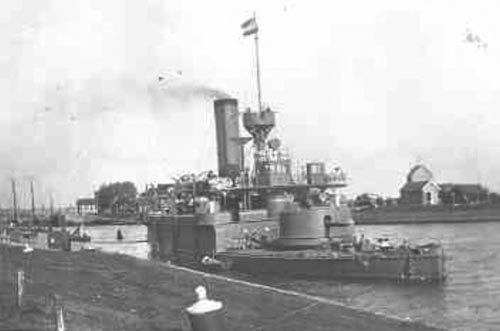
On April 22, 1913, HMS Reinier Claeszen was drydocked at Hellevoetsluis for full maintenance and conversion, but work was stopped on November 28, 1913 and on 21 April 1914 she was was decommissioned, used as a floating oil depot when the war broke out, freeing crews where they were needed. On November 21, 1915 she was sold, for 40,539 ans scrapped later. Quick specs (see the 1898 fleet for details -upcoming): 2479 tons, 70 m x 13,52 m x 4,55 m, crew 159, 2 VTE, 6 Coal-fired boilers 2,315 shp, 12,5 kts, 96 tons coal, crew 160. She was armed with a single forward turret Krupp 8.2 inches/32 (210 mm), a single 6.7in/35 aft (173 mm), four 4-pdr and two 14-inches TTs (356 mm).
Evertsen class (1894)
Evertsen, Piet Hein, Kortenaer

Three 3,500 tonnes coast defense ships were built at Fijenoord, Amsterdam and de Schelde Yards, all launched in 1894 and completed in 1895-96. They were the firsts with a complete waterline armoured belt. They were better armed also, with no less than three (one twin and one single) 210 mm/35 Krupp guns, two single 150mm/35 Krupp guns, six single Vickers 75mm guns and three 450mm torpedo tubes. Their armor reached 150mm thick for the belt and 240mm for the gun turrets faces.
Quick specs: 3463 tons standard, 86.2 x 14.33 x 5.23 m. 2 VTE engines, 6 coal-fired boilers, 4,700 shp, 16 knots, 289 tonnes of coal in store. Crew 263 men.
Only Kortenaer on paper, was still operational when WWI broke out. Evertsen was discarded in 1913 and Piet Hein in 1914, actually just before the war broke out.

Koningin Regentes class (1900)
K. Regentes, De Ruyter, H. Hendrik, M.H. Tromp, J.V. Hermskerck.
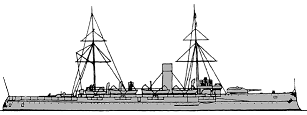
K.Regentes 1914
Another serie of three (and two modified ones) coastal battleships as planned in 1894, but this time provided by two large guns (240 mm, 9.4 inches) fore and aft in individual turrets, slightly better speed and better protection overall. They were built in the same slipways as the three Eversten class, laid down in 1898-1901 and launched in 1900-1902, commissioned in 1902-1904, so they were still relatively recent when WWI broke out. They represented by then the bulk of the defense coast fleet, alongside Tromp and Van Hermskerck. As earlier ships, they had a single funnel and two masts, with a low profile and forecastle, so the aft turret was one deck lower, and in general better seakeeping qualities and seaworthiness as well as handling.
These three ships were still in service in 1920: K. Regentes was decomm. that year, De Ruyter in 1923, but Hertog Hendrik was still in service when WW2 broke out (see that section). Marten Harpertzoon Tromp was built at Amsterdam in 1903-1904, commissioned April 1906 on a modified design: The only difference were the secondary 5.9 inches guns single-mounted on the beam were now in turrets again fore and aft close to the main turrets, and the lighter guns under shields on the broadside. For the rest, Tromp had the not same displacement, but 210 tonnes more, she was larger at 110.78 x 15.19 x 5.69 m, a belt 6.4 inches thick, turrets faces downgraded at 8 inches, but like the rest, Krupp guns and armor. Jacob Van Hermskerck on her part was slighlty lighter and shorter (4920 tonnes, 98 x 15.19 x 5.69 m), but she had two additional 5.9 in guns amidships. Both vessels were still active in WW2. Hertog Hendrik became the German floating FLAK-batterie KMS Ariadne and Van Hermskerck KMS Undine.
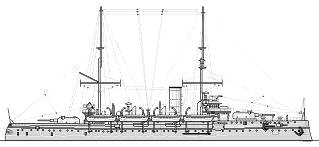
Van Hermskerck 1908
Specifications (K. Regentes)
Displacement: 5002 tons
Dimensions: 96.41 x 15.19 x 5.82 m ()
Propulsion: 2 VTE, 8 boilers, 6,500 shp, 16.5 kts, 736 tons coal
Armament: 2x 240 mm (9.4 in), 4x 149 mm (5.9 in), 8x 13-pdr, 1x 1-pdr, 3x 457mm (18-in) TTs
Crew: 340
De Zeven Provincien (1909)

Although all previous coastal battleships derived from 1860-70s monitors, HMS De Zeven Privincien became the closest to a pre-dreadnought the Dutch Navy would ever have: This unique ship reached 6,530 tonnes, which was half the tonnage of a small pre-dreadnought, she was not as fat, but at least her main armamment now reached battleship standard, with a pair of 280 mm Krupp guns. Compared to a 12-inches, the German gun compensated by slightly more accuracy and range. The seocndary armament still consisted in four 150 mm, this time in hull recesses. The hull was designed to be more seaworthy and the flush-deck hull was taller. Dimensions were slightly larger, about 80 cm more in beam, more draught as well. However she was not faster than previous ships.
Built in Amsterdam NyD, she was laid down in February 1908, launched in march 1909 and completed in October 1910, having trained extensively for four years when the war broke out; After the war she stayed in home waters instead of being sent to the east indies. In 1933 a serious mutiny was quelled by a bomb dropped by a navy seaplane, killing 32. Laid up, she was converted as a training ship in 1935-36 with paret of her powerplant removed (five boilers and forefunnel) and the rest converted and her armament altered. In 1937 she was recommissioned as Soerabaya, and served in the East Indies (see the WW2 Dutch Navy for more), sunk in 1942 by IJN aviation.
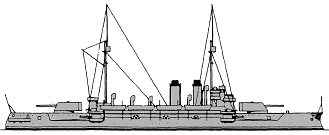
General Scheme
Specifications (1914)
Displacement: 6,530 tons
Dimensions: 103.50 x 16 x 6.20 m ()
Propulsion: 2 shafts VTE, 8 Yarrow boilers, 8,000 shp, 16 kts, 1030 tons coal
Armament: 2x 280mm/42 (11 in), 4x 150mm/40 (5.9 in), 10x 75mm, 4x 37mm, 1x 9pdr mortar, 2 MGs.
Crew: 452
WW1 Dutch Cruisers

HrMs Tromp of the Atjeh class unprotected master crusiers (1877)
The lineage of Dutch Cruisers is the following: HMS Adolf Hartog Van Nassau, a 1861 Frigate, Anna Pulowna, a 1867 screw corvette, the eight Djambi class screw corvettes (1860-72), and the seven Atjeh class, unprotected cruisers (1876-86) –More. Ships active in WW1 were the following: Sumatra, K.W.Der Neth., the famous Holland class, and the late war Java class.
Sumatra (1890)

A small protected cruiser (1,693 tonnes) with a 38mm thick turtleback armor deck. She was armed with a single 210mm gun (8.2in/35) forward and single 150mm (5.9 in/35) aft, both under shields, and the two 120mm in sponsons, abreast the foremast. In addition the cruiser carried four 1-pdr QF guns and two 1-pdr howitzers that can be transferred on a boat for landing parties and two 14-in (305 mm) torpedo tubes. Quick Specs: 69,97 x 11,30 x 4,67m (230 x 37 x 15ft), two VTE steam engines, two propellers and four boilers for 2350 shp and 17 knots. With her low, flush deck hull, much broader at the center, and ram, she was not much more than a glorified gunboat. Plan. Built in Rijkswerf Amsterdam between 5.3.1888 and 2.6.1891 she had a fairly short career, discarded in 1907, but still extant as an utility hulk during WW1.
Koningin Wilhelmina der Netherlanden (1892)

A much larger protected cruiser intended for home waters, she was built in Amsterdam, launched 1892. Much larger at 4,530 tonnes, she was unusually designed, with a single 11 inches/30 (283 mm) forward single 8.2 inches (209 mm) aft, two 6.7 inches (173 mm) on the broadsides, four 75mm/37 Krupp, six 37mm/20 Hotchkiss QF, and four multiple barrel 37mm/17 Hotchkiss HMG plus four 356mm TTs (1 bow, 2 beam, 1 stern). Quick specs: 99.8 x 14.9 x 6.07m, 2 shafts, four VTE, 6 cylindrical boilers, 4600 shp, 15.8 knots, 411 tons coal for 1800 nm at 10 kts plus rigging. She was protected by a 50 mm compound deck armor with 75mm slopes, and had barbette 280 mm thicj for the main turret, which had a 280 mm face. She too had a short career, discarded and stricken in March 1910.
Holland class (1896)
K. Regentes, H. Hendrik, M.H. Tromp, J.V. Hermskerck.
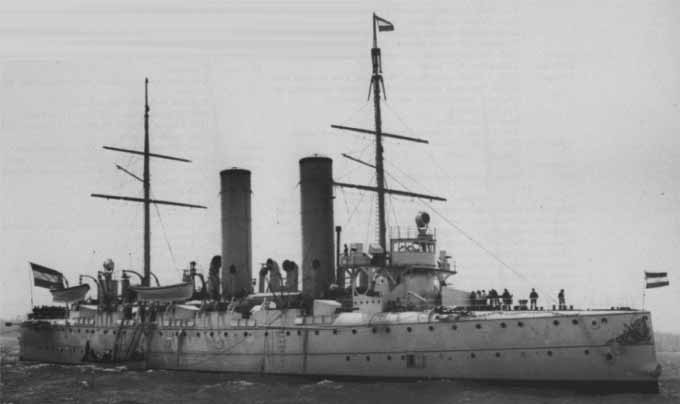
In 1886, the Dutch naval staff planned an ambitious new class of six ships to serve as long range commerce raiders, in distant stations like i the East Indies, but morever to take place in the defence of the homeland. They were to be all named after Dutch provinces and inspired by the British Apollo class. As protected cruisers, they were a good compromise for the limited economy of the country, not costly as armoured cruisers (and perfectly out of question since there was no battle line to fill), but yet, better protected than second class light cruisers of the time.
Built in two groups in various locations, launched in 1896-98 and completed by 1898-1901 these pantserdekschepen had quite an active service, seeing and participating in the Second Boer War, the Boxer war, Aceh War, or second Castro crisis. Due to budget cuts only four would remain active in 1913, two decommissioned. Holland, Zeeland saw WW1 and were discarded in 1920-24 while the last, Gelderland and Noordbrabant wee still active in 1940 as minelayers and training vessels. Both have been modernized prior to the great war.
Java class (1920)
Java, Sumatra, Celebes, laid down 1916-17
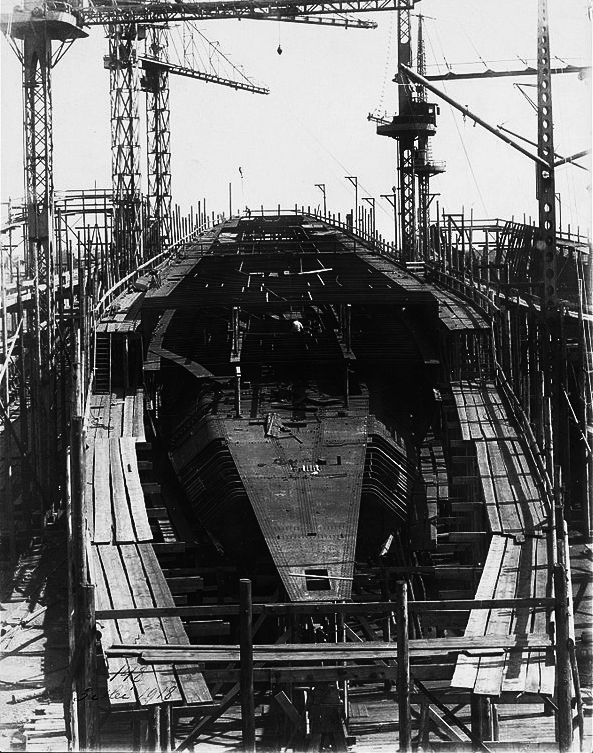
The three cruisers of the Java class were started in 1916-17 to replace older units in the Dutch Navy squadron. The class counted the HLMNS Java, Sumatra and Celebes, but construction of the third was delayed and finally was abandoned in 1919, resources being focused on the remaining two. They were eventually completed in 1923, and entered service in 1924. Already these ships were of an obsolete design with their single masked artillery positions of 6-in mounts, but both were fitted with a catapult to launch Fairey IIID seaplanes.
WW1 Dutch Destroyers
Fret class destroyers (1910)
Bulhound, Fret, Jackhals, Wolf, Hermelijn, Lynx, Panter, Vos

Of the initial naval plan of 1905, eight destroyers were voted and construction started in 1909, loosely inspired by British designs, they mostly of a purely domestic design, and the first Dutch destroyers ever. Unlike Germany which Hochseetprpedoboote or high seas TBs were derived from a long line of torpedo boats, the Dutch vessels shared nothing with its last class of torpedo boats. They were designed to operate with the fleet, and shared the same speed and range required. Called “Fret”, or “Wolf” they were commonly known as the “roodfier” class, the “predators”.
Displacing 510 t however they were on the small side, sharing this with the British River class. They were powered by four Yarrow boilers producing 8,500 hp (6,300 kW), mated with two Krupp-Germania steam turbines. They all ran on coal but the last four (Lynx, Hermelijin, Vos, Panter) had a small oil tank 12.5 t for fuel injection and an additional 340 nmi of endurance. Armament was relatively weak, with four 75 mm/52 and four 7.92 mm machine guns, but only two single 450 mm (18 in) torpedo tubes. Completed in 1911-1914 they served for a short time, being discarded in 1922-34.

Specifications (1911)
Displacement: 510 tons
Dimensions: 70.5 x 6.6 x 2.8 m (231 x 22 x 9 ft)
Propulsion: 2 shafts VTE, 4 Yarrow boilers, 8,500 shp, 30 kts, 120 tons coal
Armament: 4x 75mm (3 in), 4x 0.3 in MGs, 2x 450 mm TTs.
Crew: 83
WW1 Dutch Torpedo Boats
First class Torpedo Boats (1886-1915)
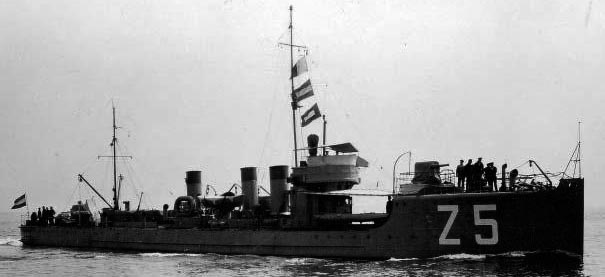
In 1914, the Dutch Navy aligned some 21 first-class (with six more in construction) and five 2nd class ones, so 26 in all.
Ardjoeno group (1886): 80-90 tonnes, 10 ship initially, of which only four were still active 1914.
Lamongan group (1890): 59 tonnes, 3 ship initially, only HMS Makjan active 1914.
Hydra group (1900): 101 tonnes, 5 ships.
Ophir group (1901): 140 tonnes, 4 ships.
Draak class (1906): 103 tonnes, 3 ships.
G1 class (1906): 140 tonnes, 12 ships.
G13 class (1913): 180 tonnes, 4 ships, also WW2
Z1 class (1914): 277 tonnes, 4 ships, all seized > Germany. Still active WW2 also
Z5 class (1915): 263 tonnes, 2 ships, completed 1916-17, also WW2.
Second class Torpedo Boats (1886-1915)

XV group (1881): 30 tonnes, 2 ships, none active 1914.
Etna group (1882): 45 tonnes, 2 ships, none active 1914.
III/XXI group (1890): 37 tonnes, 3 ships, one active 1914.
K1 group (1900): 47 tonnes, 3 ships, all active 1914.
WW1 Dutch submarines
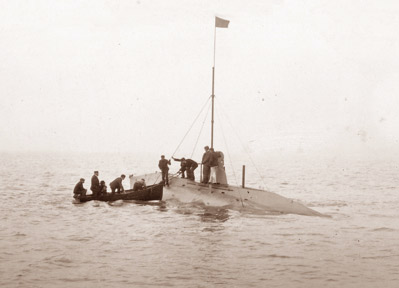
Not many were present in home waters to change the course of history. Coastal in nature, they were held in harbour defense for the duration of the war. All in all, seven submarines, and in addition a single one (K1) was deployed in the Dutch east indies (see later). In addition, the Dutch Netherlands Navy had a single German Type UC I submarine in service, called M1 after being recommissioned, and a single British H-class submarine, called O 8. The first was the ex UC-8, stranded near the Frisian island of Terschelling on 6 November 1915 and captured, after her crew opened the valves to sink her. She was recovered and repaired, interned, and then acquired from Germany, entering service in January 1917. Her fate is not known with certainty, she was either scrapped after the war or kept as a training boat.
O 8 was the ex H-6, stranded also, but on Schiermonnikog on 18 January 1916. She was refloated and interned, because the country remained staunchly neutral during the conflict. By agreement, when was acquired by the government and pressed into commission in May 1917. She had a long service time, for whole the interwar, not surprising due to the quality of these boats (see WW1 British Submarines). In May 1940 she was captured in Den Helder by the Germans. They turned her as the UD-1, used as a training boat, and later was repatriated in Germany. She was scuttled in Kiel in May 1945.
O 1:
The First Dutch submarine, built at De Schelde Yard as a private venture in Vlissingen, after the Dutch Navy purchased plans from Electric Boat Co. He first name was Luctor de Energo, and she was -as anticipated by the yard- purchased by the Navy and renamed Hrms O 1. She was launched in July 1905 but commissioned in December 1906, completion and trials leading to many fixes. Basically a very early commercial Holland boat, she was typical of the type, fast and agile after diving, slow and short range on surface. Initially fitted with a petrol motor, it was replaced in 1914 by a MAN diesel engine. It saw service during the war as a coastal/training boat and was stricken in 1920. She displaced 105/124 tonnes and was capable to reach 8 knots on surface, 6 underwater, and carried a single 250 mm TT (9.8 in).
O 2 class:
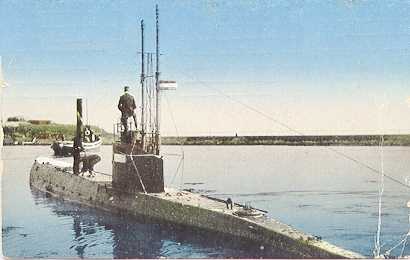
O2 class: O2-O5 were basically the main submarine class in service when the Netherlands went at war in August 1915. They were all built at De Schelde, based on plans prepared by the British engineer Marley F Hay, and Whitehead & Co in Fiume (a famous torpedo manufacturer since the 1870s). Laid down in 1909-1912 they were completed in 1911-1914, but already obsolescent as the war started. Despite of this, they were modernized after WW1 and maintained in service as training/coastal submersibles until stricken in 1931-35.
Specifications
Displacement: 130/150t
Dimensions: 31.1 x 3.1 x 2.9 m (102ft x 10ft 2in x 9ft 6in)
Propulsion: 1 shaft MAN diesel 6-cyl, 1 electric motor 350/200 shp, 11/8.6 knots
Range: 500 nm/10 kts, 26 nm/8.6 kts underwater
Armament: Two 450 mm TTs (17.7 in)
Crew: 10
O 6 class:
Wartime submarines (launched 1916), comprising O6 and O7. They were born from different yards (O7 from Fijenoord) and sufficiently different for some authors to have them separated.
O 6 was indeed of the Holland type, O 7 of the Hay-denny type. The O 6 was ordered on 8 May 1913, laid down in May 1914 in Flushing, De Schelde, launched on 10 June 1915 or 15 July 1916, comm. on 5 December 1916. During the war she remained based in Den Helder. In early june 1920 she made a trip to Norway, visiting Odda, Bergen, Gudvangen and back. In June 1923 she was used by Professor F.A. Vening Meinesz for gravity measurements in the North Sea. Without no other notable events she was decommissioned in November 1936. O 7 was ordered on 8 May 1913, laid down on 12 May 1914 the O 7 in Rotterdam, Maatschappij Fijenoord, launched on 22 July 1916 and commissioned on 23 December 1916. Nothing notable happened during WW1 as she was posted as O 7.
On 18 May 1927 she collided with the Swedish steamer Scania off the coast of Texel, but survived and was repaired. From 1935 she was used only as a training vessel, until December 1936 decommissioned and sold for scrapping, but still extant in 1940, when the Germans invaded the Netherlands. Captured, she was of no use and stayed idle, until sinking on 2 May 1944 in Den Helder because of water leaking and scrapped after the war.
Specifications (O 7 in brackets)
Displacement: 189/229 (716/206 t)
Dimensions: 37.7 x 3.8 x 3 m (34.2 x 3.7 x 2.9 m)
Propulsion: 1 shaft MAN diesel +EM 375/185 shp (350), 12/8.5 kts
Armament: 3x 450 mm (17.7 in) TTs bow and stern, 1 MG
Crew: 15
WW1 Dutch Gunboats
Assimilated to sloops five vessels preceded proper gunboats in the naval inventory: HMS Watergeus (1986), Marnix (1867), Alkmaar (1874), Sommelsdjik (1882) and Java (1885). They were all masted and retired long before WWI. Gunboats were divided into two classes, above and below 500 tonnes. For the 1st class gunboats, this went from 541 to 800 tonnes. For the 2ns class, the 1874 Hydra and Wodan classes. Like most of the others, they were all discarded before WW1 started. We will only focus on a the latest of them:

Ashahan of the Koetei class
- Lombok class (1892) 590 tons, 52.4 m long, 12.33 kts, 3x 4.7 in
- Borneo (1892) 790 tons, 53.83 m long, 13.2 kts, 6x 4.1 in, 3x 1-pdr
- Nias clss (1895) 808 tons, 53.9 m long, 12.9 kts, 1x 4.1 in, 6x 1-pdr
- Koetei class (1898) 788 tons, 53.7 m long, 13.7 kts, 2x 4.1, 6x 1-pdr
- Brinio class (1912) 540 tons, same as before but 14 kts. All extant WW2.
WW1 Dutch Minelayers
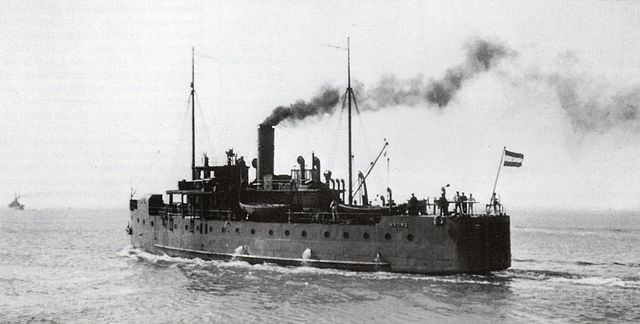
Hydra class
Focus shifted from gunboats to minelayers as a way to built a potent coastal deterrent in case of war. These were mostly light ships, most converted.
- Hydra class (1911) 2 ships: 593 tons, 49.7x9x2.75m, 900 ihp, 11 kts, 3x 75 mm, 2x 12.7mm, 70 mines
- Trawler class (1902) 2 converted trawlers, 410-477t, 38-39m long, 2x 37mm, 30 mines
- HMS Hercules (1910) Converted 234 tons tug, 1x 37mm, 20 mines
- Van Merland class (1919) Two extra “hydra” class built in 1919-21, see WW2 section.
- M1 class tugs (1916) Four requisitioned tugs (M1-M4), also extant in WW2.
Read More
https://en.wikipedia.org/wiki/List_of_battleships_of_the_Netherlands
https://www.fr.naval-encyclopedia.com/1ere-guerre-mondiale/marine-hollandaise1914.php
https://encyclopedia.1914-1918-online.net/article/the_netherlands
https://www.navypedia.org/ships/netherlands/nl_index.htm



 Latest Facebook Entry -
Latest Facebook Entry -  X(Tweeter) Naval Encyclopedia's deck archive
X(Tweeter) Naval Encyclopedia's deck archive Instagram (@navalencyc)
Instagram (@navalencyc)





 French Navy
French Navy Royal Navy
Royal Navy Russian Navy
Russian Navy Armada Espanola
Armada Espanola Austrian Navy
Austrian Navy K.u.K. Kriegsmarine
K.u.K. Kriegsmarine Dansk Marine
Dansk Marine Nautiko Hellenon
Nautiko Hellenon Koninklije Marine 1870
Koninklije Marine 1870 Marinha do Brasil
Marinha do Brasil Osmanlı Donanması
Osmanlı Donanması Marina Do Peru
Marina Do Peru Marinha do Portugal
Marinha do Portugal Regia Marina 1870
Regia Marina 1870 Nihhon Kaigun 1870
Nihhon Kaigun 1870 Preußische Marine 1870
Preußische Marine 1870 Russkiy Flot 1870
Russkiy Flot 1870 Svenska marinen
Svenska marinen Søværnet
Søværnet Union Navy
Union Navy Confederate Navy
Confederate Navy Armada de Argentina
Armada de Argentina Imperial Chinese Navy
Imperial Chinese Navy Marinha do Portugal
Marinha do Portugal Mexico
Mexico Kaiserliche Marine
Kaiserliche Marine 1898 US Navy
1898 US Navy Sovietskiy Flot
Sovietskiy Flot Royal Canadian Navy
Royal Canadian Navy Royal Australian Navy
Royal Australian Navy RNZN Fleet
RNZN Fleet Chinese Navy 1937
Chinese Navy 1937 Kriegsmarine
Kriegsmarine Chilean Navy
Chilean Navy Danish Navy
Danish Navy Finnish Navy
Finnish Navy Hellenic Navy
Hellenic Navy Polish Navy
Polish Navy Romanian Navy
Romanian Navy Turkish Navy
Turkish Navy Royal Yugoslav Navy
Royal Yugoslav Navy Royal Thai Navy
Royal Thai Navy Minor Navies
Minor Navies Albania
Albania Austria
Austria Belgium
Belgium Columbia
Columbia Costa Rica
Costa Rica Cuba
Cuba Czechoslovakia
Czechoslovakia Dominican Republic
Dominican Republic Haiti
Haiti Hungary
Hungary Honduras
Honduras Estonia
Estonia Iceland
Iceland Eire
Eire Equador
Equador Iran
Iran Iraq
Iraq Latvia
Latvia Liberia
Liberia Lithuania
Lithuania Mandchukuo
Mandchukuo Morocco
Morocco Nicaragua
Nicaragua Persia
Persia San Salvador
San Salvador Sarawak
Sarawak Uruguay
Uruguay Venezuela
Venezuela Zanzibar
Zanzibar Warsaw Pact Navies
Warsaw Pact Navies Bulgaria
Bulgaria Hungary
Hungary

 Bundesmarine
Bundesmarine Dutch Navy
Dutch Navy Hellenic Navy
Hellenic Navy Marina Militare
Marina Militare Yugoslav Navy
Yugoslav Navy Chinese Navy
Chinese Navy Indian Navy
Indian Navy Indonesian Navy
Indonesian Navy JMSDF
JMSDF North Korean Navy
North Korean Navy Pakistani Navy
Pakistani Navy Philippines Navy
Philippines Navy ROKN
ROKN Rep. of Singapore Navy
Rep. of Singapore Navy Taiwanese Navy
Taiwanese Navy IDF Navy
IDF Navy Saudi Navy
Saudi Navy Royal New Zealand Navy
Royal New Zealand Navy Egyptian Navy
Egyptian Navy South African Navy
South African Navy






























 Ukrainian Navy
Ukrainian Navy dbodesign
dbodesign